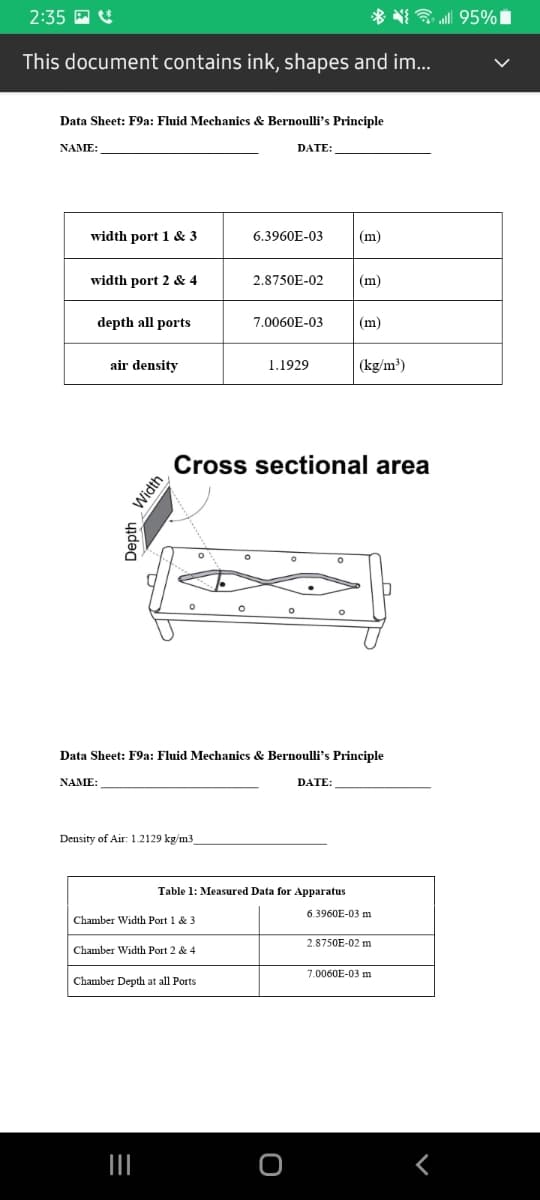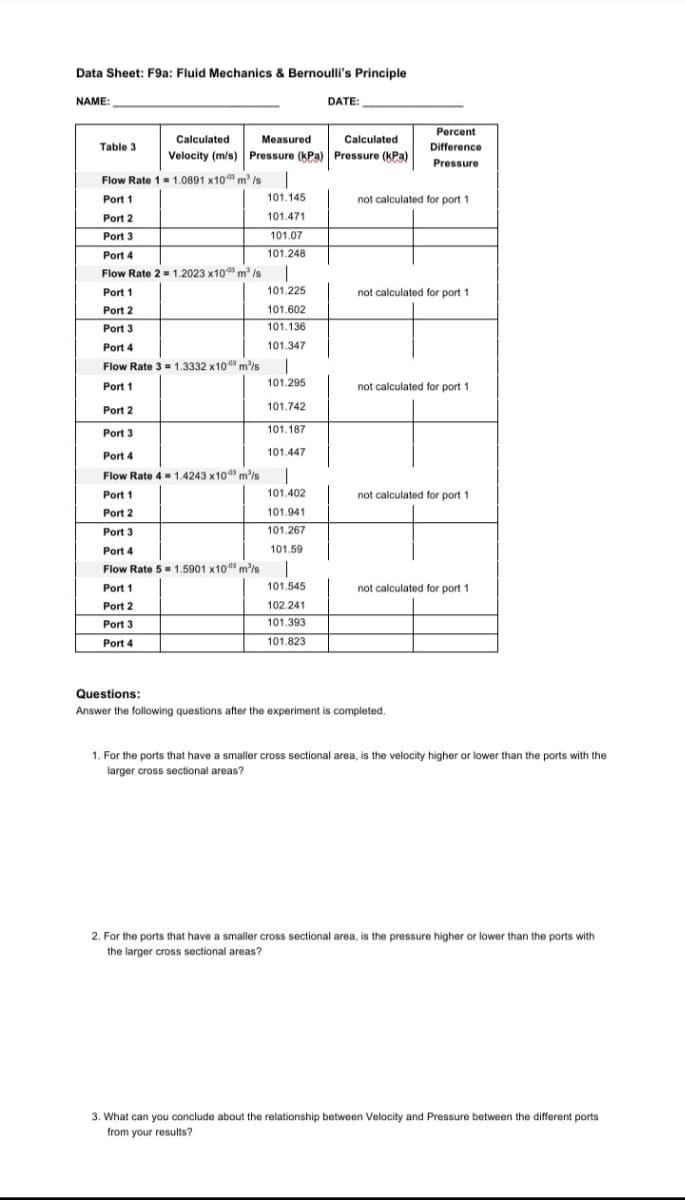Data Sheet: F9a: Fluid Mechanics & Bernoulli's Principle NAME: DATE: width port 1 & 3 6.3960E-03 (m) width port 2 & 4 2.8750E-02 |(m) depth all ports 7.0060E-03 (m) air density |(kg/m³) 1.1929 Cross sectional area Depth
Data Sheet: F9a: Fluid Mechanics & Bernoulli's Principle NAME: DATE: width port 1 & 3 6.3960E-03 (m) width port 2 & 4 2.8750E-02 |(m) depth all ports 7.0060E-03 (m) air density |(kg/m³) 1.1929 Cross sectional area Depth
Principles of Heat Transfer (Activate Learning with these NEW titles from Engineering!)
8th Edition
ISBN:9781305387102
Author:Kreith, Frank; Manglik, Raj M.
Publisher:Kreith, Frank; Manglik, Raj M.
Chapter5: Analysis Of Convection Heat Transfer
Section: Chapter Questions
Problem 5.5P: Evaluate the dimensionless groups hcD/k,UD/, and cp/k for water, n-butyl alcohol, mercury, hydrogen,...
Related questions
Question

Transcribed Image Text:2:35 A U
* N a 95%i
This document contains ink, shapes and im..
Data Sheet: F9a: Fluid Mechanics & Bernoulli's Principle
NAME:
DATE:
width port 1 & 3
6.3960E-03
(m)
width port 2 & 4
2.8750E-02
(m)
depth all ports
7.0060E-03
(m)
air density
1.1929
(kg/m³)
Cross sectional area
Data Sheet: F9a: Fluid Mechanics & Bernoulli's Principle
NAME:
DATE:
Density of Air: 1.2129 kg/m3
Table 1: Measured Data for Apparatus
6.3960E-03 m
Chamber Width Port 1 & 3
2.8750E-02 m
Chamber Width Port 2 & 4
7.0060E-03 m
Chamber Depth at all Ports
Width
Depth

Transcribed Image Text:Data Sheet: F9a: Fluid Mechanics & Bernoull's Principle
NAME:
DATE:
Percent
Calculated
Measured
Calculated
Table 3
Difference
Velocity (m/s) Pressure (kPa) Pressure (kPa)
Pressure
Flow Rate 1= 1.0891 x10 m /s
|
Port 1
101.145
not calculated for port 1
Port 2
101.471
Port 3
101.07
Port 4
101.248
Flow Rate 2 = 1.2023 x10 m /s
Port 1
101.225
not calculated for port 1
Port 2
101.602
Port 3
101.136
Port 4
101.347
Flow Rate 3 = 1.3332 x100 m/s
Port 1
101.295
not calculated for port 1
Port 2
101.742
Port 3
101.187
101.447
Port 4
Flow Rate 4 = 1.4243 x10 m'/s
Port 1
101.402
not calculated for port 1
Port 2
101.941
Port 3
101.267
Port 4
101.59
Flow Rate 5= 1.5901 x1009 m'/s
Port 1
101.545
not calculated for port 1
Port 2
102.241
Port 3
101.393
Port 4
101.823
Questions:
Answer the following questions after the experiment is completed.
1. For the ports that have a smaller cross sectional area, is the velocity higher or lower than the ports with the
larger cross sectional areas?
2. For the ports that have a smaller cross sectional area, is the pressure higher or lower than the ports with
the larger cross sectional areas?
3. What can you conclude about the relationship between Velocity and Pressure between the different ports
from your results?
Expert Solution
This question has been solved!
Explore an expertly crafted, step-by-step solution for a thorough understanding of key concepts.
This is a popular solution!
Trending now
This is a popular solution!
Step by step
Solved in 3 steps

Knowledge Booster
Learn more about
Need a deep-dive on the concept behind this application? Look no further. Learn more about this topic, mechanical-engineering and related others by exploring similar questions and additional content below.Recommended textbooks for you

Principles of Heat Transfer (Activate Learning wi…
Mechanical Engineering
ISBN:
9781305387102
Author:
Kreith, Frank; Manglik, Raj M.
Publisher:
Cengage Learning

Principles of Heat Transfer (Activate Learning wi…
Mechanical Engineering
ISBN:
9781305387102
Author:
Kreith, Frank; Manglik, Raj M.
Publisher:
Cengage Learning